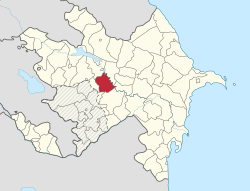Barda District
Bərdə | |
|---|---|
 Map of Azerbaijan showing Barda Rayon | |
| Country | Azerbaijan |
| Capital | Barda |
| Area | |
| • Total | 960 km2 (370 sq mi) |
| Population (1999 census) | |
| • Total | 129,600 |
| • Density | 140/km2 (350/sq mi) |
| Postal code | 0900 |
| Telephone code | (+994) 20[1] |
Barda (Bərdə) is a rayon of Azerbaijan, and its capital city is Barda. There is 1 city and 110 villages in the Rayon, with two of which are named the same thing - Qazaxlar.[2]
History
This section may require copy editing. (August 2018) |
Barda Rayon was established in 1930 as an independent administrative unit.
The materials and coins, found in archaeological excavations, related to the period of Alexander the Great, Arakis and Empire of Rome proved that the center of the district-Barda city is one of the oldest centers not only in Azerbaijan but also in the Middle East. According to the information given by Arabian historian Al-Baladhuri (9th century), Barda city was built in the period of Kavadh I who was Sassanid ruler, to Iranian historian Hamdallah Mustawfi (14th century) in the period of Alexander the Great (336–323 BC)[3]
Barda became the center of the region ruled by the governor during the period of Sassanid. During the period of Kavadh I, Barda was surrounded by fortress walls. It was a capital of Albania in the 10th century. The centre of Albanian church was moved to the Barda city in 552 and was occupied by Iranian feudalists in 639. Thereafter, Barda received autonomy by the help of Javanshir who was the ruler of Alban. It became a central part of Arran province in 752. Barda was part of the Sassanid state until the 890s.[3]
The remains of cultural items, covering from the 2nd millennium BC to the last Middle Ages, were found and preserved in Barda. The cultural items were Barda tomb built in 1322, remains of old city walls belonging to the 6th century, Ibrahim Mosque and cemetery of the 18th century, two bridges dating back to 7th–9th centuries on the Tartar river, the Axsadan Baba tomb of 14th century and an eight-point tomb in the village of Guloghlular dating back to the 18th century. All of these findings are well-preserved by the government. In addition, the Juma mosque built in 1905 (Barda city), the bathhouse of the 19th century, the Ugurbeyli mosque (19th century), Bahman Mirza Mausoleum[4] and other historical and architectural monuments were found in Shirvanli village.[3]
Barda consisted of two parts: Shahristan and Rabad. The city center part was in Shahristan. The Shahristan was surrounded by fortress walls. Meanwhile, there were craftsmen, merchants, and caravanserais in the place called Rabat.[3]
Monuments
Historical monuments left to date are as follows:
- Ibrahim Mosque (built in the 8th–9th centuries)
- Bahram Mirza Tomb
- “Akhsadan baba” Tomb
- Barda Tomb
- “Torpag gala”
- Juma Mosque
- 2 bridges over Tartar river[5]
Economy
Barda is well-developed agricultural on. The main agricultural sectors include grain and cotton growing. The economy is primarily based upon cattle-breeding, vegetable growing and silkworm breeding.
Barda rayon has a developed industry. There are “Yag-Pendir” (“Butter-Cheese”) and “Garabag-Pambig” (“Grabag-Cotton”) OSJCs, cannery, etc. functioning in the rayon.
The rayon runs education, health, social, recreational and public catering facilities.[6]
Population
The population of the district was 143.9 thousand people until January 1, 2011. According to the official information dated 01.06.2012, the population of the region is 147700. Among the residents there are 222 Karabakh war invalids, 438 martyrs, 884 Karabakh war veterans and 41 the Great Patriotic War veterans.[7]
| Population | |
| Ethnic group | census, 2009 |
| Total | 141 646 |
| Azerbaijanis | 141 485 |
| Turkish people | 97 |
| Russians | 48 |
| Ukrainians | 5 |
| Tatars | 5 |
| Others | 6 |
| Towns and Regions | 2011 | 2012 | ||||
| Total | men | women | Total | men | women | |
| Barda district | 143,9 | 72,1 | 71,8 | 146,6 | 73,5 | 73,1 |
| Barda city | 38,1 | 18,6 | 19,5 | 38,5 | 18,9 | 19,6 |
| Rural population | 105,8 | 53,5 | 52,3 | 108,1 | 54,6 | 53,5 |
Geographical location
Barda city is located on the Kur-Araz lowland, 87 meters above sea level, in the center of the Karabakh plain. The region is bordered by the Tartar region in the west, Yevlakh region in the north, Aghdash region in the north-east and the east, Zardab region in the south-east along the Kur River and the Aghdam and Aghjabadi regions in the south.
References
- ^ "Şəhərlərarası telefon kodları". Aztelekom MMC. Aztelekom İB. Retrieved 19 August 2015. Template:Az
- ^ Ministry of Economic Development[permanent dead link]
- ^ a b c d "TERRITORIAL AND ADMINISTRATIVE UNITS-District of Barda" (PDF).
{{cite web}}: Cite has empty unknown parameter:|dead-url=(help) - ^ "(in Azerbaijani) Bahman Mirza Mausoleum".
{{cite web}}: Cite has empty unknown parameter:|dead-url=(help) - ^ "Official page of Barda district".
{{cite web}}: Cite has empty unknown parameter:|dead-url=(help) - ^ Barda rayon[permanent dead link]
- ^ "According to the State Statistical Committee "Size of population by sex, towns and regions, urban settlements of the Republic of Azerbaijan at the beginning of 2000-2016 (thsd persons)"".
{{cite web}}: Cite has empty unknown parameter:|dead-url=(help)
